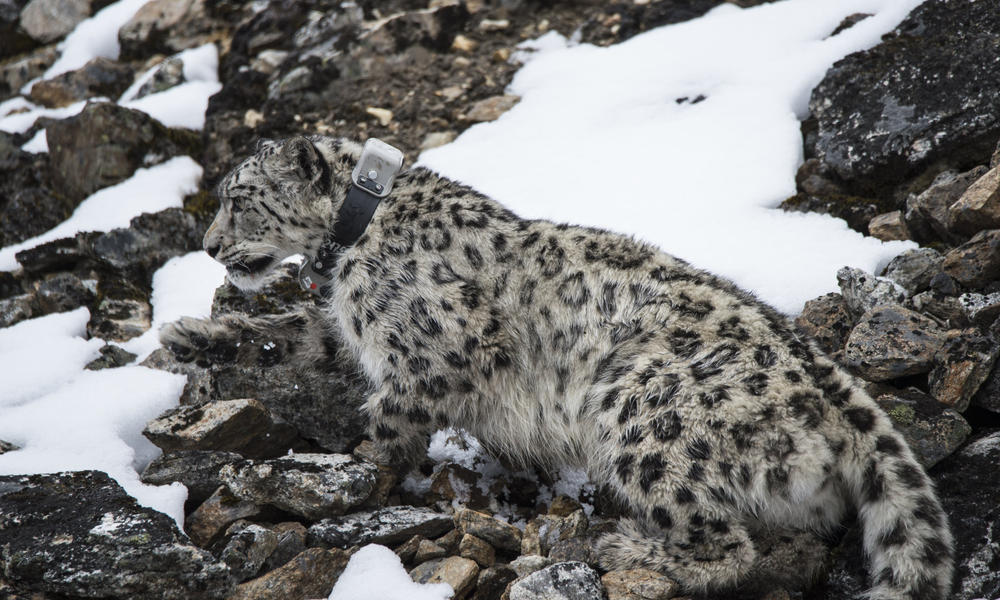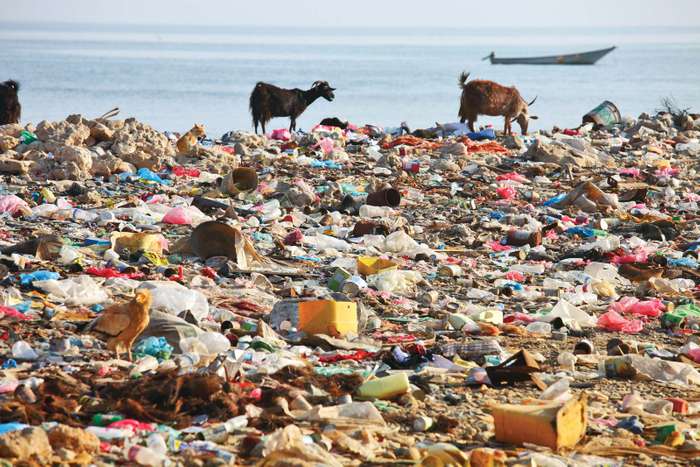
 Local people, Technicians and experts after attaching satellite GPS Tracker. photo: WWF Nepal[/caption]
Zeborong was left in Bhijer in the mountainous region, at an altitude of 4,171 meters in the Charcarbo region. It reached at an altitude of 6,298 meters in search of food and returned back in April. Acharya said that signals were not available from May 4.
"Based on the GPS point, the activity of the snow leopard should be received through SMS in the computer," said Acharya. "After May 4, both the snow leopards have not given any signal."
Zeborong weighed 38 kg and was 3 to 4 years old when he tied the GPS collar. On November 18 last year, another male snow leopard was also connected to a satellite collar at an altitude of 3,885 meters near the Samling Gumba, which was named 'Samling'.
Samling weighed 33 kg and was 4 to 5 years old. 'Samling' also climbed up to 6,252 meters in search of food and returned downward last April.
According to Kamal Thapa, an expert on snow leopard, noir and weasel are his main food. There are more noirs in Shey-Phoksundo. "Sixty to 70 per cent of the diet is noir and weasel," said Thapa. "Besides, 30 to 40 per cent of the diet are cows, chicks, chickens, fox mice and deer."
According to Thapa, the snow leopard was first studied in Nepal by a foreign researcher named George Schaller. In 1970, he travelled from Pokhara to Dolpa via Dhorpatan to study. "Snow Leopard is found in Nepal was spread all over the world by him," Thapa said.
About 12 years later, American wildlife expert Rodney Jackson used a radio collar to study the diet and condition of snow leopards.
Under the leadership of the department, satellite collars were attached to the necks of four snow leopards in the Kanchenjunga Conservation Area of Taplejung. It showed that leopards roamed as far as Tibet of China and Bhutan.
Minister of Forests, Shakti Bahadur Basnet had decided to connect collars to 12 snow leopards on August 31, 2018, to find out the habitat and migration of snow leopards and to study their food status.
[caption id="attachment_1888" align="alignnone" width="1024"]
Local people, Technicians and experts after attaching satellite GPS Tracker. photo: WWF Nepal[/caption]
Zeborong was left in Bhijer in the mountainous region, at an altitude of 4,171 meters in the Charcarbo region. It reached at an altitude of 6,298 meters in search of food and returned back in April. Acharya said that signals were not available from May 4.
"Based on the GPS point, the activity of the snow leopard should be received through SMS in the computer," said Acharya. "After May 4, both the snow leopards have not given any signal."
Zeborong weighed 38 kg and was 3 to 4 years old when he tied the GPS collar. On November 18 last year, another male snow leopard was also connected to a satellite collar at an altitude of 3,885 meters near the Samling Gumba, which was named 'Samling'.
Samling weighed 33 kg and was 4 to 5 years old. 'Samling' also climbed up to 6,252 meters in search of food and returned downward last April.
According to Kamal Thapa, an expert on snow leopard, noir and weasel are his main food. There are more noirs in Shey-Phoksundo. "Sixty to 70 per cent of the diet is noir and weasel," said Thapa. "Besides, 30 to 40 per cent of the diet are cows, chicks, chickens, fox mice and deer."
According to Thapa, the snow leopard was first studied in Nepal by a foreign researcher named George Schaller. In 1970, he travelled from Pokhara to Dolpa via Dhorpatan to study. "Snow Leopard is found in Nepal was spread all over the world by him," Thapa said.
About 12 years later, American wildlife expert Rodney Jackson used a radio collar to study the diet and condition of snow leopards.
Under the leadership of the department, satellite collars were attached to the necks of four snow leopards in the Kanchenjunga Conservation Area of Taplejung. It showed that leopards roamed as far as Tibet of China and Bhutan.
Minister of Forests, Shakti Bahadur Basnet had decided to connect collars to 12 snow leopards on August 31, 2018, to find out the habitat and migration of snow leopards and to study their food status.
[caption id="attachment_1888" align="alignnone" width="1024"] Samling, Nepal's fifth collared snow leopard
Samling, Nepal's fifth collared snow leopard© DNPWC/WWF Nepal[/caption] In the first phase, collars were added to two snow leopards in Shey-Phoksundo in the last fiscal year. The department says that collars will be connected to two more in the same park. The department plans to add collars to eight more snow leopards in Annapurna and Manaslu areas within five years. According to the technicians, the information received from the radio collars will help in formulating conservation strategies in the future and helps in exchanging geo-periphery. Also, it will be easy to coordinate and cooperate with other countries. According to the availability of snow leopards, the conservation area of Nepal has been divided into three parts. Eastern Block including Kanchenjunga Conservation Area, Makalu Barun, Sagarmatha and Langtang National Park and Gaurishankar Conservation Area; Center Block including Manaslu Conservation Area and Annapurna Conservation Area; and Western Block containing Dhorpatan Game Reserve, She-Foksundo, Rara and Khaptad National Park with Api Nampa Conservation Area. So, snow leopards are found within these three blocks. This beautiful and attractive wildlife, which is on the protected list in Nepal, is listed in CITES Appendix I and is on the Vulnerable list of the red list of IUCN. Snow leopard experts Som Aale and Sarudatta Mishra have objected to this and insisted that the number should not be upgraded from critical without any confirmation in its number. The shy natured snow leopard is found in 12 countries including Nepal, Afghanistan, Pakistan, China, Kyrgyzstan, Kazakhstan, Tajikistan, Uzbekistan, Russia, Bhutan, India and Mongolia. The number of snow leopards worldwide is estimated at 3,000 to 6,000. According to old statistics, there are around 3 to 5 hundreds of snow leopards in Nepal. 23 landscapes have been identified in 12 countries for snow leopards. Among them, 3 are in Nepal. In 12 countries, the area inhabited by snow leopards is 1.77 million square kilometres. Translated from the online version of Ekantipur published on 28th October, 2020, and written by Abdullah Mian.









Facebook Comments